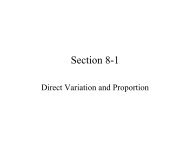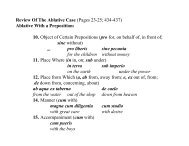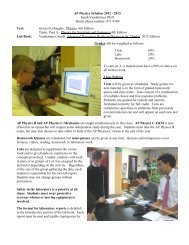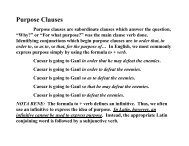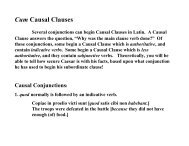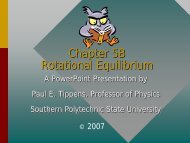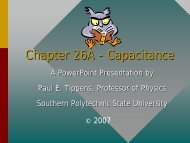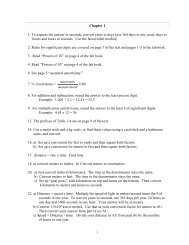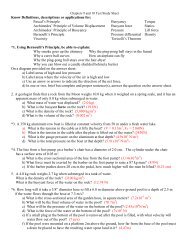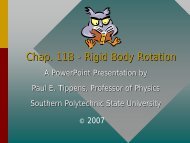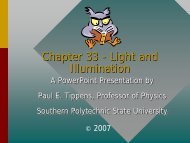Homework Hints Chapter 04.pdf
Homework Hints Chapter 04.pdf
Homework Hints Chapter 04.pdf
You also want an ePaper? Increase the reach of your titles
YUMPU automatically turns print PDFs into web optimized ePapers that Google loves.
26. a) Draw the lawnmower and, using arrows, show all horizontal and vertical forces. Youmay not use any oblique lines.b) You have a push force and a retarding force (a combination of friction in the wheelsand against the ground) horizontally. Since the velocity is constant, the resultantforce = 0. The forward push force is equal to the horizontal component of the 88.0 Nforce directed along the handle. Use this information to solve for the retarding force.F(ret)Fp(x)c) The lawnmower has no vertical motion, so the vertical resultant force = 0. There arethree vertical forces acting on the lawnmower. These include the weight of the mower,the (y) component of the 88.0 N force directed along the handle pushing down and thenormal force pushing back up. Use this information to calculate the normal force on thelawnmower.d) This part of the problem must be solved in three steps.i) There is now a horizontal resultant force which = ma. The lawnmowerstarts from rest so the initial velocity will be 0. You are also given timeand final velocity. List your variables and choose from VAT, VAX orVATX to solve for the horizontal acceleration.ii) Use F = ma to find the resultant horizontal force using the resultantacceleration you just found. This resultant horizontal force is equal to thesum of the horizontal forces. (F res = F forward + F retarding ). You found theretarding force in part b, and that hasn’t changed. You also know theresultant force. Use this information to solve for the horizontal componentof the new forward push force.iii) The new horizontal push force is the x-component of the new forcedirected along the handle. Use trigonometry to find the new push force(the hypotenuse) along the handle.25. a) The top cord has 2 buckets hanging from it, so include both masses when you solve forthe tension in the cord. The bottom cord has only 1 bucket hanging from it. If thebuckets are at rest, there is no resultant force, and the tension up should be equal to thegravitational force pulling down..b) This is an elevator going up problem. See the homework hint for problem 12. Youwill have to solve this problem twice, once for each bucket.31. Use Example 4-20 on page 93.32. The vertical component in this triangle is acceleration due to gravity and the horizontalcomponent is given. Use trigonometry and find the angle.13




